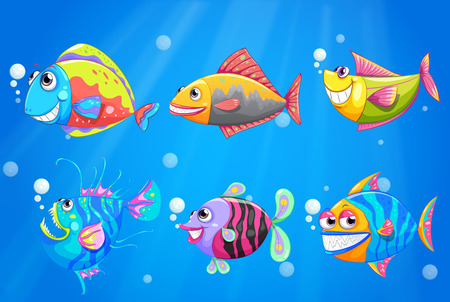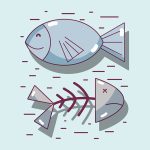1. Understanding the Key Differences Between Freshwater and Saltwater Fishing
When it comes to choosing the right fishing line, knowing the difference between freshwater and saltwater fishing is key. These two environments vary greatly in terms of water conditions, target species, and fishing techniques—factors that all play a major role in your choice of fishing line.
Environment Matters
The first big difference is the water itself. Freshwater environments—like lakes, rivers, and ponds—are less corrosive and generally calmer than saltwater settings like oceans and bays. Saltwater is highly corrosive and often rougher due to tides, waves, and wind. Because of this, saltwater fishing gear—including your fishing line—needs to be more durable and resistant to damage from both the environment and larger fish.
Target Species
Another key difference lies in the fish youre after. In freshwater, youre typically targeting species like bass, trout, crappie, or catfish. These fish are usually smaller and less aggressive than saltwater species. On the other hand, saltwater anglers might go after powerful game fish like redfish, snook, tarpon, or even sharks. These larger fish require stronger lines with higher abrasion resistance and greater pound-test ratings.
Fishing Techniques
The style of fishing also changes depending on where you are. In freshwater, finesse techniques like drop shotting or using light tackle are common. These methods work best with lighter lines that offer better sensitivity. Saltwater fishing often involves trolling, bottom fishing, or casting heavy lures—all of which require sturdier lines capable of handling long runs and strong strikes.
Comparison Table: Freshwater vs Saltwater Fishing Line Needs
| Feature | Freshwater | Saltwater |
|---|---|---|
| Water Conditions | Calm & Non-Corrosive | Rough & Corrosive |
| Typical Fish Size | Small to Medium (e.g., Bass, Trout) | Medium to Large (e.g., Redfish, Tarpon) |
| Abrasion Resistance Needed | Low to Moderate | High |
| Pound-Test Range | 4–12 lb typically | 15–50+ lb depending on species |
| Tackle Type Used | Lighter Tackle / Finesse Gear | Heavier Rods & Reels |
| Main Line Material Preference | Monofilament or Fluorocarbon for stealth | Braided for strength & durability |
Why It All Matters for Your Fishing Line Choice
If you use a light monofilament line meant for freshwater while fishing in the ocean, chances are it’ll snap under pressure—or degrade quickly from salt exposure. Likewise, using a heavy braided line in a small lake might scare off skittish fish and reduce your catch rate. Matching your line to the environment ensures better performance, longer gear life, and more successful days on the water.
This basic understanding lays the groundwork for making smart choices when picking out your next spool of line—whether youre hitting a calm lake or heading offshore.
2. Types of Fishing Lines Explained
When it comes to choosing the right fishing line for freshwater or saltwater, understanding the different types of lines is key. Each type has its own strengths and weaknesses, and knowing how they perform in various conditions can make a big difference in your fishing success. Lets break down the three most common types: monofilament, fluorocarbon, and braided lines.
Monofilament Line
Monofilament, often called “mono,” is one of the most popular and beginner-friendly fishing lines out there. Its made from a single strand of nylon and is known for its flexibility and stretch.
Pros:
- Affordable and widely available
- Easy to handle and knot
- Good stretch helps absorb shock from fighting fish
- Floats well—great for topwater baits
Cons:
- More visible underwater than other types
- Tends to degrade over time with UV exposure
- Less sensitive due to stretch
Best Use:
Great for freshwater fishing, especially with beginners or when using topwater lures.
Fluorocarbon Line
Fluorocarbon is made from a denser material than mono and offers near invisibility underwater, making it ideal for clear water situations.
Pros:
- Virtually invisible underwater—perfect for spooky fish
- Abrasion-resistant—good around rocks and structure
- Sinks faster—great for bottom-contact techniques
- More sensitive than mono
Cons:
- Stiffer and harder to manage, especially on spinning reels
- Tends to be more expensive
- Can be brittle in cold temperatures
Best Use:
Ideal for both freshwater and saltwater when stealth is needed, like finesse fishing or targeting pressured fish.
Braided Line
Braided line is made by weaving together several strands of synthetic fiber, creating a super strong and thin line with no stretch.
Pros:
- Extremely strong for its diameter—more line capacity on your reel
- No stretch—excellent sensitivity for detecting light bites
- Lasts longer than mono or fluoro if maintained properly
- Cuts through vegetation easily—great for heavy cover fishing
Cons:
- Highly visible in clear water unless paired with a leader
- Tends to slip on reel spools without backing material
- Knot tying can be trickier due to slickness
- Abrasive on rod guides if not designed for braid use
Best Use:
A favorite in saltwater fishing for big game species or heavy cover situations in freshwater like bass fishing in thick weeds.
Comparison Table of Fishing Line Types
| Feature | Monofilament | Fluorocarbon | Braided Line |
|---|---|---|---|
| Visibility Underwater | High | Low (Nearly Invisible) | High (Needs Leader) |
| Sensitivity | Low to Medium | Medium to High | High (No Stretch) |
| Abrasion Resistance | Moderate | High | Very High (But may fray) |
| Knot Strength & Ease of Use | Easy to tie knots | Difficult with some knots | Slick; knots require practice |
| Lifespan & Durability | Lowers over time (UV-sensitive) | Brittle with age but durable short-term | Long-lasting if maintained well |
| Main Water Type Usage* | Mainly Freshwater | Both Freshwater & Saltwater* | Mainly Saltwater or Heavy Cover Freshwater* |
| Sinking/Floating Behavior | Floats (Good for topwater) | Sinks (Good for bottom lures) | Sinks (Fast drop rate) |
| Total Cost Level ($ – $$$) | $ (Budget-friendly) | $$$ (Premium-priced) | $$ (Mid-range) |
*Note: All line types can technically be used in either environment, but their properties tend to lend themselves better to specific applications.
Selecting the right line type depends on where youre fishing, what youre targeting, and how you plan to present your bait. Knowing these basics will help you pick the perfect setup whether youre casting into a lake or battling waves offshore.
![]()
3. Best Fishing Lines for Freshwater Angling
When it comes to freshwater fishing, picking the right line can make all the difference. Whether youre casting into a calm pond, drifting down a river, or working structure-heavy lake beds, your fishing line needs to match the environment and target species like bass, trout, and catfish. Heres a breakdown of the best types of lines for different freshwater conditions.
Key Factors to Consider
- Water Clarity: Clear water calls for low-visibility lines like fluorocarbon.
- Structure: Areas with rocks, logs, or weeds may require abrasion-resistant lines.
- Target Species: Heavier fish like catfish need stronger test lines, while lighter lines work well for trout.
Top Line Types for Freshwater Fishing
| Line Type | Best For | Pros | Cons |
|---|---|---|---|
| Monofilament | Ponds, lakes, beginners | Affordable, easy to handle, good stretch | Less sensitive, weaker in diameter compared to others |
| Braided Line | Heavy cover, targeting bass or catfish | High strength-to-diameter ratio, very sensitive | Easily visible in clear water, can be pricey |
| Fluorocarbon | Clear water lakes and rivers, finesse fishing | Nearly invisible underwater, sinks faster than mono | Stiffer and harder to manage on spinning reels |
Recommended Setups by Species
Bass Fishing (Largemouth & Smallmouth)
- Braided mainline (30–50 lb test) with a fluorocarbon leader (10–15 lb test) for fishing around heavy cover.
- Monofilament (10–12 lb test) for topwater presentations due to its buoyancy and stretch.
Trout Fishing (Streams & Lakes)
- Fluorocarbon (4–6 lb test) for stealthy presentations in clear water.
- Monofilament (2–6 lb test) works well in smaller streams where casting distance isnt as critical.
Catfish Fishing (Rivers & Lakes)
- Braided line (30–80 lb test) for handling big blues or flatheads around structure.
- Monofilament (15–25 lb test) is a solid option for channel cats in open water.
No matter where youre fishing—whether its a quiet pond at sunrise or a fast-moving river—choosing the right line gives you better control, more bites, and fewer lost fish. Matching your line type to the conditions and species is key to successful freshwater angling.
4. Best Fishing Lines for Saltwater Fishing
When it comes to saltwater fishing, choosing the right line can make all the difference. Whether youre casting inshore or heading offshore, saltwater conditions are tough on gear. You’ll need a fishing line that can handle corrosion from salt, resist abrasion from rocks and reefs, and stand up to powerful fish like tuna, redfish, or tarpon.
Inshore vs Offshore: What to Consider
The type of saltwater fishing you’re doing plays a big role in picking the right line. Inshore anglers deal with smaller species and lighter cover, while offshore fishermen go after bigger, stronger fish in deeper water. Here’s a quick comparison:
| Fishing Type | Target Species | Recommended Line Type | Key Features |
|---|---|---|---|
| Inshore | Redfish, Snook, Sea Trout | Braided or Fluorocarbon Leader | Sensitivity, Low Stretch, Abrasion Resistance |
| Offshore | Tuna, Mahi-Mahi, Sailfish | Monofilament or Braided with Heavy Mono Leader | Shock Absorption, Strength, Durability |
Braided Line for Saltwater Fishing
Braided lines are extremely popular among saltwater anglers because of their high strength-to-diameter ratio and low stretch. Theyre perfect for feeling subtle bites and cutting through heavy cover. However, they don’t offer much stretch, so pairing them with a fluorocarbon or monofilament leader is often necessary to handle sudden strikes and reduce visibility in clear water.
Benefits:
- Excellent sensitivity for detecting bites
- High strength for pulling big fish out of structure
- Long casting distance due to thin diameter
Monofilament Line for Saltwater Fishing
Monofilament remains a solid choice for many saltwater applications. It’s affordable and provides natural stretch, which helps absorb shock when fighting large fish. Its also more forgiving if your drag isnt set perfectly.
Benefits:
- Stretch helps prevent break-offs during aggressive runs
- Easier to tie knots with compared to braid
- Sinks slower – good for topwater presentations
Fluorocarbon Leaders in Saltwater Fishing
No matter what mainline you use, adding a fluorocarbon leader is smart in saltwater environments. It’s nearly invisible underwater and offers great abrasion resistance against rocks, coral, and sharp teeth.
Best Used For:
- Tying to braided lines for stealthy presentation
- Abrasion protection around structure or reefs
- Catching species with sharp teeth like mackerel or bluefish
Line Strength and Diameter: Match Your Target Fish
You’ll want to match your line strength (measured in pound-test) to the size of the fish youre targeting. Heres a simple guide:
| Target Fish Size | Pound Test Range (lb) |
|---|---|
| Small (1–10 lb) | 6–12 lb test |
| Medium (10–30 lb) | 15–25 lb test |
| Large (30+ lb) | 30–80 lb test or higher with braid + leader setup |
Selecting the right saltwater fishing line means thinking about where youre fishing, what youre targeting, and the kind of conditions youll face. With the right combo of mainline and leader material, you’ll be ready to take on even the toughest challenges in the ocean.
5. Tips for Switching Between Freshwater and Saltwater Gear
If you’re someone who enjoys both freshwater and saltwater fishing, it’s important to know how to properly switch between the two environments. Saltwater is more corrosive, and the demands on your gear are different. Here are some practical tips to help keep your fishing line and equipment in top shape when switching back and forth.
Maintain Your Gear Regularly
Saltwater can be brutal on your gear, especially if youre not diligent with cleaning. After every saltwater trip, rinse all your rods, reels, and tackle with fresh water. Pay close attention to your reel and line guides—salt residue can build up quickly. For freshwater trips, regular wipe-downs will do the trick but don’t skip maintenance altogether.
Cleaning Checklist:
| Gear | After Saltwater Use | After Freshwater Use |
|---|---|---|
| Rods & Reels | Rinse with fresh water, dry thoroughly, lubricate metal parts | Wipe down with damp cloth, dry completely |
| Fishing Line | Check for salt build-up or wear; replace if needed | Inspect for frays or knots; replace if worn |
| Tackle (hooks, lures) | Soak briefly in fresh water, dry well to prevent rust | Quick rinse or wipe-down as needed |
Avoid Cross-Contamination
If youre using the same gear in both environments, cross-contamination can lead to corrosion or biological transfer between ecosystems. Always clean your gear thoroughly before moving from one environment to another. Even a bit of leftover salt can cause rust or affect performance during your next freshwater outing.
Selecting Versatile Fishing Lines
If you frequently fish in both freshwater and saltwater, consider using fishing lines that can handle both types of conditions. While no line is perfect for every situation, some options are more versatile than others.
Recommended Line Types:
| Line Type | Freshwater Suitability | Saltwater Suitability | Notes |
|---|---|---|---|
| Braided Line | Excellent sensitivity and strength for bass and walleye | Highly resistant to abrasion and salt damage | A great all-around choice; just rinse well after salt use |
| Fluorocarbon Line | Low visibility underwater; good for clear lakes and streams | Decent resistance to salt corrosion when maintained properly | Ideal as a leader material in both environments |
| Nylon Monofilament | User-friendly with good stretch; great for beginners | Prone to faster degradation in saltwater unless rinsed well | Budget-friendly but may require frequent replacement if used in saltwater often |
A Few Extra Tips:
- Label your spools: Keep separate spools labeled “Fresh” and “Salt” if you like switching lines depending on location.
- Use corrosion-resistant gear: Look for reels with sealed bearings and anodized components if you fish saltwater regularly.
- Packing smart: Bring extra cleaning supplies like a spray bottle of fresh water or corrosion inhibitor when traveling between locations.
- Create a routine: The more consistent you are with gear care, the longer your equipment—and your fishing line—will last.
Treat your gear right, choose the right line for each type of water, and youll enjoy smooth transitions whether youre casting into a mountain lake or battling reds on the coast.


